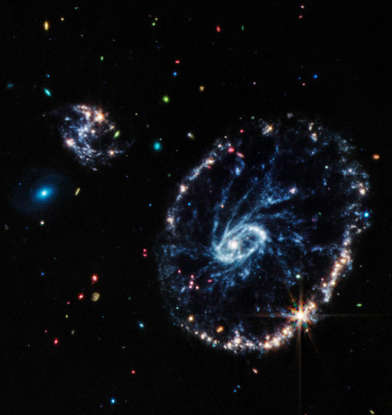
The James Webb Telescope has taken some of the clearest images beyond the Milky Way, but its most recent photos took a very detailed look at the king of our solar system – Jupiter.
The images, released by NASA on Monday, were taken using the telescope’s near-infrared camera, which has three infrared filters “that showcase details of the planet” that can’t be seen by the human eye.
The first image released is a collection of images taken from Jupiter against the darkness of space. The red and orange glow at the top and bottom of the planet show the auroras at the northern and southern poles, with green and yellow hazes swirling around. The rest of the enormous planet has blue shades to show light is reflected from a deeper main cloud, NASA says.
Also viewable is Jupiter’s infamous Great Red Spot. The storm, which has a bigger diameter than Earth and can produce winds over 400 miles per hour, is white because the clouds are reflecting a substantial amount of sunlight.
“The numerous bright white ‘spots’ and ‘streaks’ are likely very high-altitude cloud tops of condensed convective storms,” Heidi Hammel, Webb interdisciplinary scientist for solar system observations and vice president for science at the Association of Universities for Research in Astronomy, said in a statement.
The second images takes a wide-look at the planet, and noticeable are rings around Jupiter, which “are a million times fainter than the planet,” NASA says. Jupiter, Saturn and Uranus are the planets with rings in our solar system.
Tiny specs in the picture show two of the planet’s at least 79 moons – Amalthea and Adrastea. Fuzzy spots in the distance are likely to be other galaxies.
NASA said the images will give scientists more clues to discovering what Jupiter’s inner life is like. The planet is bigger than all of the other planets in our solar system combined, according to NASA, and has extreme temperatures under -100 degrees Fahrenheit.
“We hadn’t really expected it to be this good, to be honest,” said Imke de Pater, professor emerita of the University of California, Berkeley who helped lead the planet’s observations at NASA. “It’s really remarkable that we can see details on Jupiter together with its rings, tiny satellites and even galaxies in one image.”






